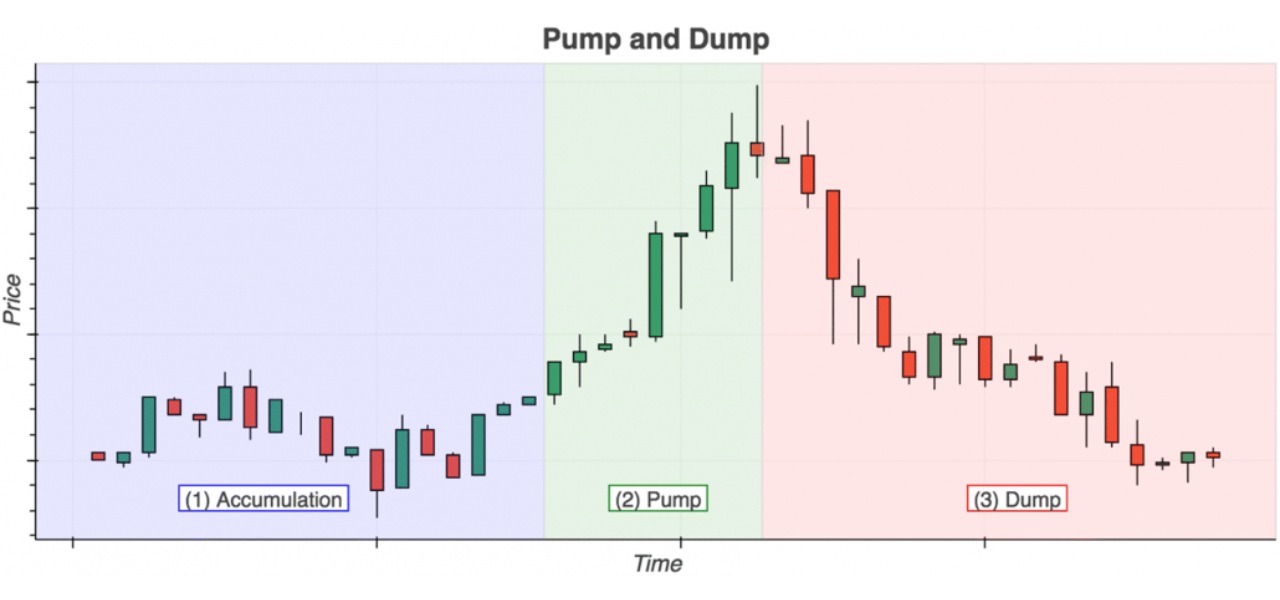Introduction
Welcome to the world of wash trading in the realm of cryptocurrencies! If you’ve been following the cryptocurrency market, you may have come across the term “wash trading” and wondered what it entails. In this article, we will delve into the concept of wash trading in the crypto space, exploring its mechanics, motivations, and the problems it poses.
So, what exactly is wash trading? Simply put, it is the practice of buying and selling assets, in this case, cryptocurrencies, to create an appearance of trading activity without any genuine intent of executing real transactions. It involves a trader or entity simultaneously acting as both the buyer and seller, artificially inflating the trading volume and giving the illusion of market liquidity.
Wash trading has been prevalent in various financial markets, and the crypto industry is no exception. With its decentralized and relatively unregulated nature, the crypto market has provided an environment where wash trading can occur more easily. While wash trading is not illegal per se, it is widely regarded as a deceptive practice that undermines the integrity and transparency of the market.
In the following sections, we will explore how wash trading works in the crypto space, the motivations behind it, the negative implications it has on the market, as well as the steps taken to detect and prevent it.
Knowledge of wash trading is crucial for both traders and investors, as it can greatly impact market dynamics, asset valuation, and the overall trust in the crypto market. By understanding the intricacies of wash trading, you can make more informed decisions and navigate the crypto landscape with greater confidence.
What is Wash Trading?
Wash trading is a deceptive trading practice where a trader or entity buys and sells assets, such as cryptocurrencies, with themselves, giving the appearance of genuine market activity. The term “wash” comes from the idea that the trades are essentially “washing” each other out, resulting in no real change in ownership or transaction. It is important to note that wash trading is not exclusive to the cryptocurrency market and has been observed in various financial markets as well.
In a typical wash trading scenario, the person or entity involved will place simultaneous buy and sell orders for the same crypto asset at roughly the same price. These orders are often executed on the same exchange and are designed to create artificial volume and activity in the market. The primary purpose of wash trading is to manipulate trading data and deceive other market participants into believing that there is significant interest and liquidity in a particular cryptocurrency.
There are several techniques used in wash trading to make it appear more convincing. One common technique is the use of multiple trading accounts controlled by the same entity. This allows them to create a semblance of transactions between different parties when, in reality, they are all controlled by the same person or entity. Another technique is spoofing, where large buy or sell orders are placed and quickly canceled to give the impression of significant market demand or supply.
While wash trading can occur in any financial market, it is particularly prevalent in the cryptocurrency industry due to its decentralized and largely unregulated nature. Many cryptocurrency exchanges have low liquidity, making them an easy target for wash trading activities. Additionally, with the absence of stringent regulations and oversight, it becomes easier for traders to engage in manipulative practices without facing significant consequences.
Although wash trading itself is not illegal in some jurisdictions, it is widely condemned as it undermines market transparency and integrity. It misleads investors and traders by providing inaccurate trading data and distorts the true supply and demand dynamics of a cryptocurrency. This lack of transparency can have severe consequences, such as artificially inflating prices, misleading market sentiment, and even facilitating pump and dump schemes.
In the next section, we will examine how wash trading works specifically in the context of the cryptocurrency market and explore the motivations behind these deceptive practices.
How Does Wash Trading Work in Crypto?
Wash trading in the cryptocurrency market involves creating artificial trading activity and volume to mislead market participants. It typically occurs on crypto exchanges, which act as the platforms for buying and selling digital assets. Let’s explore how wash trading works in the context of cryptocurrencies.
One of the primary ways wash trading is facilitated in the crypto market is through the use of multiple trading accounts controlled by the same entity. The person or group behind the wash trading activity will create several accounts on the exchange and use them to execute buy and sell orders between themselves. These transactions create the illusion of active trading and boost the trading volume of the cryptocurrency.
Another method used in wash trading is the manipulation of order books. Traders place large buy or sell orders at specific price levels to create the appearance of deep market liquidity. These orders may not be intended to be filled, but rather to deceive other market participants into thinking that there is significant interest in trading the cryptocurrency at that particular price point.
Spoofing is another technique commonly employed in wash trading. Traders place large orders with the intention to cancel them before they get executed. This tactic creates a false impression of market demand or supply, as the orders are quickly removed from the order book. By doing so, the traders can manipulate the market sentiment and attract other investors or traders to join in on the perceived trend.
Certain wash trading activities in cryptocurrency are also conducted through off-exchange transactions. These transactions occur outside the exchange’s order book and are designed to manipulate the price of a cryptocurrency. The wash trader may collude with other individuals or entities, executing coordinated trades to drive the price up or down, creating a false market movement.
Wash trading is further facilitated by the lack of regulation and transparency in the crypto market. Unlike traditional financial markets, cryptocurrency exchanges are often unregulated or lightly regulated, allowing individuals and entities to carry out wash trading activities with little to no repercussions. The absence of strict oversight and reporting requirements makes it more challenging to detect and prevent wash trading in the crypto space.
In the next section, we will uncover the motivations behind wash trading in the cryptocurrency market and examine why it is considered problematic.
Motivations for Wash Trading in Crypto
Wash trading in the cryptocurrency market is driven by various motivations and incentives, despite its deceptive nature. Understanding these motivations can provide insights into why individuals and entities engage in such manipulative practices. Let’s explore some of the key motivations behind wash trading in the realm of cryptocurrencies.
1. Manipulating Trading Volume: One of the primary motivations for wash trading is to artificially inflate the trading volume of a cryptocurrency. Higher trading volumes can create a perception of increased market activity and liquidity, attracting more traders and investors. Wash traders may seek to manipulate the trading volumes of certain cryptocurrencies to garner attention and generate hype, making their investments appear more attractive.
2. Attracting Investors and Traders: Cryptocurrencies with high trading volumes are often perceived as more popular and trustworthy. By engaging in wash trading, manipulators can create the illusion of market interest and attract new investors and traders. This can lead to increased demand for the cryptocurrency, potentially driving up its price and allowing the wash traders to profit from their positions.
3. Pump and Dump Schemes: Wash trading is sometimes used as a part of pump and dump schemes. In this scenario, manipulators artificially inflate the price of a cryptocurrency through coordinated buying and selling, creating a hype around the asset. Once the price reaches a certain level, they sell their holdings, causing the price to plummet and leaving unsuspecting investors with substantial losses.
4. Market Manipulation: Some individuals or entities may engage in wash trading in an attempt to manipulate the price of a cryptocurrency. By creating artificial buying or selling pressure, they can influence the market sentiment and direction, potentially profiting from price movements. These manipulators may have significant holdings of the cryptocurrency and aim to generate short-term profits by distorting the market.
5. Boosting Reputation: Cryptocurrency projects and exchanges often use trading volume as a metric to gauge their popularity and credibility. By engaging in wash trading, these entities can artificially boost their trading volume numbers, making them appear more influential and reputable. This can attract potential partnerships, investors, and media attention, enhancing their overall image in the crypto space.
It is important to note that wash trading is generally considered detrimental to the cryptocurrency market. It creates a false sense of market liquidity, distorts price discovery, and misleads market participants. Honest traders and investors can be adversely affected by these manipulative practices and may make decisions based on inaccurate information.
In the next section, we will explore the negative implications of wash trading and why it is crucial to detect and prevent such activities in the crypto market.
Why is Wash Trading Bad?
Wash trading, despite being a prevalent practice in the cryptocurrency market, is widely regarded as detrimental and harmful. Here are some reasons why wash trading is considered bad for the crypto ecosystem:
1. Misleading Market Data: Wash trading creates a false impression of market activity and liquidity by artificially inflating trading volumes. It distorts market data, making it difficult for traders and investors to accurately assess the true supply and demand dynamics of a cryptocurrency. This lack of transparency can lead to misguided trading decisions and undermine the integrity of the market.
2. Market Manipulation: Wash trading enables market manipulators to artificially influence the price and sentiment of a cryptocurrency. By creating fake buying or selling pressure, these manipulators can distort the market, causing unsuspecting traders and investors to make decisions based on manipulated information. This can lead to significant financial losses for those who fall victim to these schemes.
3. Lack of Price Discovery: Genuine price discovery is essential for healthy and efficient markets. Wash trading interferes with the natural process of price discovery, as the artificial trading activity distorts the market forces of supply and demand. This can result in pricing inefficiencies and prevent fair valuation of assets, leading to potential market imbalances.
4. Reduced Investor Confidence: Wash trading undermines trust in the cryptocurrency market. When investors and traders realize that the trading volumes and market activity are artificially manipulated, they may become skeptical and lose confidence in the market as a whole. This lack of trust can hinder adoption and hinder the maturation of the crypto industry.
5. Regulatory Concerns: While wash trading is not explicitly illegal in some jurisdictions, it raises regulatory concerns. Regulators have been increasingly scrutinizing the cryptocurrency market, aiming to mitigate fraudulent and deceptive practices. Wash trading can attract unwanted regulatory attention, potentially leading to stricter regulations, which could impact the overall growth and development of the crypto industry.
6. Unfair Advantage: Wash trading gives the perpetrators an unfair advantage over other market participants who are trading based on genuine information. Honest traders and investors who make decisions based on accurate market data may find themselves at a disadvantage when competing with those engaging in wash trading. This creates an uneven playing field and erodes market fairness.
By understanding the negative implications of wash trading, it becomes evident why regulatory authorities, exchanges, and market participants strive to detect and prevent such activities in the crypto market. In the next section, we will discuss the methods used to identify and combat wash trading.
Detection and Prevention of Wash Trading
Detecting and preventing wash trading in the cryptocurrency market is crucial for maintaining market integrity and protecting traders and investors from fraudulent practices. While wash trading can be challenging to identify, efforts are being made to develop sophisticated methods and implement preventive measures. Here are some approaches used for detecting and preventing wash trading:
1. Pattern Analysis: Market surveillance systems analyze trading data to identify patterns indicative of wash trading. These systems look for repetitive and symmetric trading patterns, such as simultaneous buy and sell orders executed at similar prices, that are characteristic of wash trading. By conducting thorough analyses of trading activities, suspicious patterns can be flagged for further investigation.
2. Trading Volume Analysis: Monitoring and analyzing trading volumes can help identify wash trading activity. Sudden spikes or irregularities in trading volumes, especially in low-liquidity cryptocurrencies, can indicate potential wash trading. By comparing trading volumes across different exchanges and verifying the corresponding value with transactional data, regulators and exchanges can better identify suspicious trading activities.
3. Identifying Connected Accounts: Wash traders often employ multiple trading accounts controlled by the same individual or entity to execute trades between themselves. Advanced data analytics and machine learning techniques can help identify connections between different accounts, such as shared IP addresses, trading patterns, or transactional history, making it easier to detect wash trading networks.
4. Enhanced KYC and AML Procedures: Implementing stringent Know Your Customer (KYC) and Anti-Money Laundering (AML) procedures can help mitigate wash trading. Requiring thorough verification of user identities and monitoring large transactions can discourage illicit activities and provide valuable data for identifying suspicious trading patterns.
5. Collaboration with Exchanges: Exchanges play a crucial role in detecting and preventing wash trading. By sharing data and collaborating with regulators and other exchanges, suspicious trading activities can be identified more effectively. Exchanges can also implement trading restrictions, such as minimum order size requirements, to deter wash trading.
6. Regulatory Oversight: Regulatory authorities are increasingly focusing on the cryptocurrency market to ensure fair practices. Introducing regulations and guidelines that specifically address wash trading can discourage manipulative activities and provide a framework for enforcement actions. Cooperation between regulators and industry participants is vital to detecting and penalizing those involved in wash trading.
By utilizing a combination of advanced technologies, data analysis, regulatory oversight, and collaboration between market stakeholders, efforts to detect and prevent wash trading in the cryptocurrency market can be significantly enhanced. Enhanced transparency and integrity contribute to a healthier and more trustworthy market environment for all participants.
In the next section, we will explore some real-world examples of wash trading in the crypto industry to illustrate the impact of these deceptive practices.
Examples of Wash Trading in Crypto
Wash trading has been a prevalent issue in the cryptocurrency market, with several prominent examples highlighting its impact on market integrity. Let’s explore a few notable instances of wash trading in the crypto industry:
1. Bitfinex and Tether: In 2019, the New York Attorney General accused Bitfinex, a major cryptocurrency exchange, and Tether, a stablecoin issuer, of engaging in wash trading to manipulate the price of Bitcoin. The allegation stated that Bitfinex used Tether to artificially inflate the trading volume and create a misleading impression of market demand. The case raised concerns about the transparency and legitimacy of both entities.
2. Coinbit: In August 2020, South Korean cryptocurrency exchange Coinbit was accused of wash trading and artificially inflating trading volumes. The exchange’s executives allegedly used ghost accounts to create fake transactions and manipulate the market. This fraudulent activity resulted in millions of dollars’ worth of losses for unsuspecting traders and investors.
3. 2017 Chinese Exchanges Crackdown: In 2017, the Chinese government cracked down on various cryptocurrency exchanges in the country, uncovering evidence of widespread wash trading practices. Exchanges such as OKCoin, Huobi, and BTCC were found to have artificially inflated trading volumes, leading to inflated asset prices and misleading market information.
4. Coincheck: Coincheck, a Japanese cryptocurrency exchange, faced scrutiny in 2018 after allegations of wash trading emerged. The exchange was accused of creating fake orders to manipulate trading volumes of certain cryptocurrencies. The incident highlighted the importance of regulatory oversight in preventing such deceptive practices.
These examples illustrate the detrimental effects of wash trading on the cryptocurrency market. Manipulative practices not only mislead market participants but also erode trust and hinder the development of the industry. They emphasize the need for increased vigilance, regulatory action, and collaborative efforts to combat wash trading and promote transparency.
It is worth noting that the cryptocurrency market continues to evolve, and efforts are being made to address the issue of wash trading. As regulators and exchanges implement stricter measures, develop advanced surveillance systems, and encourage transparency, the hope is to establish a more trustworthy and reliable ecosystem for traders and investors.
In the final section, we will summarize the key points discussed throughout this article and reiterate the importance of combatting wash trading in the crypto industry.
Conclusion
Wash trading in the cryptocurrency market poses significant challenges and risks to market integrity and transparency. It is a deceptive practice that manipulates trading volume, distorts market data, and misleads investors and traders. Understanding and addressing wash trading is crucial for fostering a healthy and trustworthy crypto ecosystem.
In this article, we explored the concept of wash trading, how it works in the crypto market, the motivations behind it, and the negative implications it has. We discussed the detection and prevention methods employed to identify and deter wash trading activities, including pattern analysis, volume analysis, enhanced KYC and AML procedures, collaboration between exchanges and regulators, and regulatory oversight.
Furthermore, we examined real-world examples of wash trading, such as the cases of Bitfinex and Tether, Coinbit, and the 2017 Chinese exchanges crackdown. These examples underscored the importance of combating wash trading to maintain market integrity and protect traders and investors from fraudulent practices.
As the crypto industry continues to grow and mature, efforts to detect, prevent, and penalize wash trading are being strengthened. Increased transparency, regulatory scrutiny, and cooperation between market stakeholders are essential for creating a fair and reliable market environment.
Traders and investors should remain cautious and perform thorough research before participating in the cryptocurrency market. By staying informed and aware of the risks associated with wash trading, they can make more informed decisions and help foster a crypto market that is built on trust, integrity, and genuine market activity.
As the crypto industry evolves, it is essential for regulators, exchanges, and market participants to remain vigilant and committed to safeguarding the integrity of the market. By working together, we can mitigate the impact of wash trading and pave the way for a more transparent and trustworthy future for cryptocurrencies.







